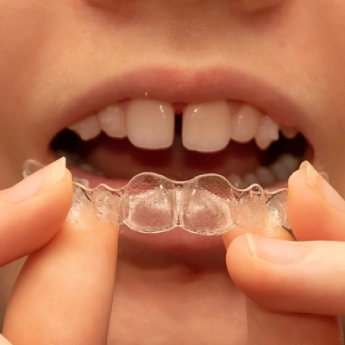Regarding aligning teeth, Invisalign® is a preferred choice for many individuals. As America’s leading clear aligner, we prioritize Invisalign for a reason, opting for it over other brands. The Invisalign system boasts cutting-edge clear aligner technology and treatment planning, making it the top choice in the market. Choosing Tamarack Hills Family Dentistry means choosing the pinnacle of clear aligner therapy provided under the expertise of a board-certified orthodontist. The virtually invisible nature of these clear aligners makes them an inconspicuous alternative for those opposed to traditional braces. Nevertheless, a common query when contemplating Invisalign is, “How Much Do Invisalign Braces Cost?”
Rest assured, at Tamarack Hills Family Dentistry, we understand this concern and are here to clarify the financial aspect of achieving a beautifully aligned smile.
How Much Do Invisalign Braces Cost?
Generally, clear aligners, like Invisalign, typically cost between $2,000 and $10,000 in the United States, and this range is often comparable to the cost of traditional braces.
It’s essential to highlight that these figures represent averages, and according to the official Invisalign website, the average cost of Invisalign treatment can range from $3,000 to $9,000.
The overall expense for clear aligners and orthodontic treatment depends on several factors, which can vary from one patient to another.
Key Factors Influencing the Invisalign Cost
The severity of the Issue
The complexity and severity of orthodontic issues being addressed significantly determine the overall cost of clear aligner treatment. More intricate cases may require additional resources, impacting the total expense.
Overall State of Your Oral Health
The existing condition of your oral health can influence the cost of clear aligners. Pre-existing dental conditions or additional oral health requirements may impact the treatment plan and associated costs.
Treatment Duration
The duration of your treatment, whether primarily straightening teeth or correcting a bite, can affect the overall cost. Longer treatment periods may necessitate more aligner sets and adjustments, contributing to a higher total expense.
Geographic Location
The location of your dental practice can influence the cost of clear aligners. Practices in different regions or areas with varying living costs may adjust their pricing accordingly.
Experience of Your Doctor
The expertise and experience of the healthcare professional overseeing your clear aligner treatment can impact the cost. Orthodontists specializing in orthodontic procedures may charge differently than general dentists providing similar services.
Maximizing Savings on Your Invisalign Journey
Orthodontic treatments enhance the aesthetics of a smile and play a crucial role in maintaining oral health. Crooked teeth can challenge oral hygiene, increasing the risk of decay, periodontal disease, and potential jaw pain. Additionally, a confident smile contributes to an improved quality of life in social and professional settings.

If you’re exploring ways to save money on Invisalign treatment, several strategies and programs are available to help reduce costs or facilitate gradual payments. Consider the following options:
Flexible Spending Accounts (FSA)
A Flexible Spending Account (FSA) allows you to allocate a predetermined pretax income for healthcare expenses. Usually offered through employers, FSAs come with a user-friendly interface and are often equipped with a debit card. Remember that funds in an FSA do not carry over to the next year, so it’s advisable to utilize them before year-end.
Health Savings Accounts (HSA)
Like an FSA, a Health Savings Account (HSA) lets you set aside pre-tax dollars for healthcare costs. Noteworthy differences include the ability of HSA funds to roll over into the next year and the requirement of a high-deductible insurance plan. As of 2018, contribution limits were $3,450 for individuals and $6,850 for families.
Payment Plans
Many dentists offer monthly payment plans to ease the financial burden of orthodontic bills. When discussing the estimated cost of orthodontic work with your dentist, inquire about available payment plans tailored to your needs.
Dental Schools
Research dental schools in your city that may provide discounted orthodontic services. Opting for treatment at a dental school involves having a dental student perform the work under the supervision of a board-certified dentist. Choosing a reputable dental school ensures quality oversight during the learning process.
No-Interest Credit Card
Consider a credit card with a 0 percent APR introductory rate as a financing option for dental work. Making regular payments and settling the balance before the initial rate expires creates an interest-free payment plan. Be cautious of credit cards with deferred interest rates, as they accumulate interest from the beginning.
Medicaid and Children’s Health Insurance Program (CHIP)
Children and teens covered by government assistance programs may qualify for assistance in covering the costs of braces or Invisalign. Coverage might be possible if orthodontic needs significantly impact a child’s health. Collaborate with your dentist and insurance representative to build a case and secure coverage, noting that regulations may vary by state.
Get Affordable Invisalign in Woodbury, MN
Ready to say goodbye to traditional metal braces and welcome the freedom of Invisalign? Schedule a consultation with the skilled dentists at Tamarack Hills Family Dentistry! Why wait any longer?
Invisalign provides a quicker, more discreet, and comfortable route to achieving a confident smile. Plus, with our flexible payment options, achieving that perfect smile is surprisingly affordable. Don’t put off your smile journey any further; take the initial step today! Contact us at (651) 432-0975, and let’s work together to create your ideal smile.
FAQs
Is Invisalign cheaper than braces?
Braces cost between $1,700 and $3,500, depending on factors such as the severity of the condition and the region where you live. Invisalign treatment, on the other hand, begins at $2,400 and goes up to $9,000. Insurance can make a difference in costs as well.
Do you sleep with Invisalign?
Invisalign works because of the near-constant pressure. Therefore, it is necessary to wear the aligners during sleep. The manufacturers of Invisalign suggest wearing the braces for 20 to 22 hours each day and only removing them while eating or brushing the teeth.
Is Invisalign worth getting?
Invisalign is far less noticeable than metal braces, typically requires only a year of treatment, imposes no food or drink restrictions, and makes brushing and flossing easier, reducing the risk of gum disease. Invisalign delivers the same results as traditional braces but without the associated drawbacks.



